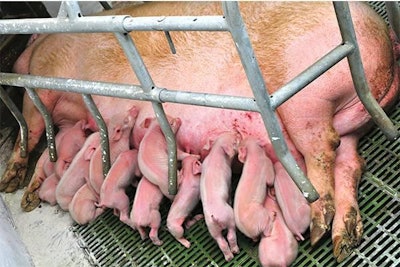
The use of hyperprolific maternal lines means that the number of piglets born and weaned is increasing. Consequently, the nutritional needs of these sows are higher. The provision of both macro- and micro-nutrients, through gestation into lactation, needs careful consideration. Specially tailored diets and strategies to optimize feed intake are essential when feeding the hyperprolific sow. Attention to detail will ensure both the health and longevity of the sow and the growth and viability of her piglets.
Nutritional needs for gestation
It has been a concern that a high plane of nutrition during early gestation can reduce embryo mortality, but recent research has not proved this effect. However, sows shouldn’t be allowed to get fat; a normal/lean body weight helps with a smooth delivery. Feed intake during lactation will also be higher, leading to an improvement in weaning weights.
Ideally, sows should be fed a number of diets through the phases of gestation. However, in many systems this isn’t practical; in this case meal size and frequency should be controlled. During mid-gestation the aim should be to meet the sow’s maintenance requirements, as fetal needs are minimal. However, it is also important to consider individual body condition score so that they all stay at an optimum weight, remembering that sow feed conversion efficiency is poor -- to put on 1 kilogram of body weight she will need to eat an extra 4-5 kilograms of feed.
In the last month of gestation, fetal growth accelerates and hence nutritional requirements increase significantly. The sow’s body also prepares for lactation through mammary development. Intakes of 3.5 kilograms per day are recommended, and amino acid requirements increase. Studies in France found that the highest feed allowance, in the last 14 days before farrowing, seemed to make farrowing easier and improved neonatal vitality.
Mineral requirements
It has been demonstrated that in the last 14 days of pregnancy approximately 50 percent of minerals in the sow are found in the developing piglets. Consequently, hyperprolific sows have a lower body mineral content, as the requirements of larger litters are greater. Similarly, mineral retention during lactation is greater as litter size increases. Nutritionists therefore suggest dietary mineral levels over and above NRC recommendations during gestation and lactation.
During gestation there is an increased need for calcium and phosphorus to support the development of the piglets, particularly later on. These needs are not easily met by the diet if they haven’t been specifically fortified with the hyperprolific sow in mind. As such, bone reserves of these minerals are used to supply the need for fetal growth or milk production. This effect is greater with large litter sizes and can result in skeletal problems for the sow.
Iron levels also warrant special attention as the amount required for fetal development increases greatly during late gestation. Iron content of milk decreases during lactation an effect that is greater in sows nursing larger litters. This suggests that these sows have lower body iron reserves and need to eat more.
Feed intake during lactation
For hyperprolific sows it is essential to provide the correct nutrition to enable her to adequately feed the piglets until they are weaned (Table 1.). Initial milk yield is dependent on the number of milk producing cells that are present in the mammary gland at the onset of lactation. If gestation diets are insufficient, mammary tissue mass will be reduced. Feeding during lactation also has a significant effect; increasing energy or protein will result in greater functional mammary weight.

Increasing ADFI of sows improves milk yield and hence piglet weaning weights.
Although nutritional balance and quality is important, the main challenge is optimizing feed intake during lactation. The importance of a fresh and adequate supply of water shouldn’t be underestimated. Intakes should be carefully calculated and monitored to make sure there isn’t any wastage. If feed is left in the feeders it should cleaned out to prevent refusal of the next meal. Increases in meal size should be carried out gradually to avoid reducing appetite and a greater number of meals can improve intake (Table 2).

Benefits to piglets and sows
Matching nutrition to individual requirements has benefits for both the sow and her piglets. There is a natural mechanism whereby the sow will partition nutrients to the developing piglets, in turn sacrificing her own body reserves and condition, potentially reducing her longevity.
There can be a tendency for the birth weights of piglets from large litters to be smaller; ensuring adequate nutrition during gestation can help to alleviate this. It is also even more important that the colostrum and milk that the sow subsequently supplies is of the best nutritional quality, as lighter-born piglets have higher rates of pre-weaning mortality, along with poorer growth and feed efficiency.
Late gestation and lactation are the critical stages for nutritional requirements for hyperprolific sows. Greater attention to diet formulation and feed intake in this transition period is key to improving productivity.
References available on request.

















